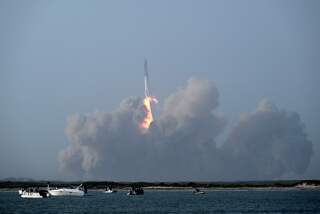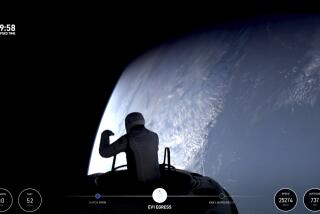Private Spaceflight Is a Public Success
MOJAVE â A rocket powered by a mixture of rubber and laughing gas soared 328,491 feet Monday to become the first privately funded vehicle to carry a person into space.
Piloted by 63-year-old Michael W. Melvill, SpaceShipOne climbed into the record books by rising to new heights.
With the suborbital flight that included 3 1/2 minutes of weightlessness, Melvill became the first human being to reach space -- defined as about 62 miles above Earth -- without any government funding or help, a feat that space enthusiasts said could usher in a new age of commercial space travel.
âI could see the curvature of Earth. I could see all the way out to San Diego and the coastline.... It was mind-boggling,â Melvill, a veteran test pilot, said shortly after making a perfect glide landing in front of about 20,000 people who came to watch the event, which was more like a rock concert than a typical space shot.
With some gazers wearing spacesuits and others carrying anti-government political signs (proclaimed one: âWeâre going to space and the government is not invitedâ), organizers unabashedly called it the Woodstock for space enthusiasts.
The flight came five weeks after Melvill took SpaceShipOne to 211,400 feet, or about 40 miles above Earth, setting an altitude record for a civilian craft and overcoming a major technical challenge to reach the edge of space.
The May 13 test gave the projectâs backers the confidence to attempt the first manned commercial spaceflight far sooner than space analysts had expected.
âIt is a great day for space exploration, not only for the record it set but for the excitement it will generate with the public,â said Bruce Betts, director of projects for the Pasadena-based Planetary Society.
The Guinness Book of World Records swiftly dubbed the rocket launch the âfirst ever privately funded manned spaceflight.â
The Federal Aviation Administration also conferred its first commercial astronaut wings on Melvill, allowing him to join an elite cadre of pilots who have flown more than 50 miles above Earth.
One of them, astronaut Buzz Aldrin, the second man to walk on the moon, was on hand to congratulate Melvill and welcome him to the âclub.â
Burt Rutan, a pioneering aircraft designer, and Paul G. Allen, a co-founder of Microsoft Corp. who is financing the project, took turns hugging Melvill as he crawled out of the tiny cockpit of SpaceShipOne. Melvill works for Rutanâs company, Scaled Composites, which is based in Mojave.
âI had my heart in my throat watching this,â said Allen, who has pumped more than $20 million into development of the rocket and the mother aircraft that carried it aloft. The amount is a far cry from the billions that the U.S. has spent on space vehicles.
Only two other countries, Russia and China, have sent astronauts into space.
Rutan contends that Mondayâs aviation milestone could spawn a private industry that within 15 to 20 years could offer regular suborbital flights costing less than $10,000 a seat. For that price, a space tourist would feel weightlessness and see the blue sky turn completely dark. Two people have already bought their way into orbit, paying $20 million each to ride in a Russian-built Soyuz.
âItâll allow all us regular people to experience space,â Rutan said.
A legend in the aerospace industry, Rutan has built pioneering aircraft including the Voyager, which made the first nonstop flight around the world in 1986 with one tank of fuel.
Within a few months, Rutan and Allen are expected to attempt to improve on Mondayâs feat in a quest to win the $10-million Ansari X-Prize, which is funded by a nonprofit foundation that promotes space tourism.
To win, SpaceShipOne must complete two trips past the 62-mile mark within a two-week period, carrying three people on each flight.
Rutan said that wouldnât be a problem. In fact, he boasted: âIâll be able to send up three flights in two weeks.â
There are 26 teams from seven countries vying for the prize, but Rutan and Allen clearly established themselves as the front-runners. Other entries include a rocket launched from a hot-air balloon and a reproduction of the German V-2 rocket that terrorized England during World War II.
With a throng of people not seen around the high desert since the space shuttle first landed at nearby Edwards Air Force Base in the early 1980s, the rocket launch evoked memories of past aviation feats that drew wide public attention.
At one point, more than 200 recreational vehicles, some from as far away as Oregon and Texas, were lined up at the gate to the airport here to witness the event. Nearly 600 press credentials for the event were handed out to reporters representing 271 news outlets from around the world.
âItâs like going out and watching the Wright brothers fly,â said Steve Manning of Bakersfield, who showed up at the gates at 3 a.m. with his 15-year-old son, Brian. âHeâll look back on this day and heâll be able to say he was there for the first commercial spaceflight.â
There was also a modern commercial twist to the event: Souvenir booths sold T-shirts, mugs and caps with the logo of SpaceShipOne, and at the Voyager restaurant at the airport, the menu included meals named after the vehicles involved in the flight: SpaceShipOne (ham and eggs) and White Knight, the mother carrier plane (bacon and eggs).
Viewers were first awed at 6:40 a.m. when the rocket, attached to the belly of the mother aircraft, rolled past the crowd. White Knight resembled a Klingon warship from a âStar Trekâ movie.
Five minutes later, the mother ship took off, with Melvill seated inside the tiny rocket.
About an hour later, after White Knight had reached 46,000 feet, the rocket was released. SpaceShipOne dropped for a few seconds before Melvill ignited the engines, propelling the rocket with combustion caused by combining rubber and nitrous oxide, also known as laughing gas.
For a brief moment, Melvill lost control of the trims on the wings that provide stability, forcing SpaceShipOne to roll and veer slightly as it shot straight up into the sky.
Using backup controls, Melvill was able to regain control of the rocket.
But the glitch kept SpaceShipOne from reaching its target of 360,000 feet, Rutan said. There was just enough fuel to propel the rocket far enough to surpass the 328,000-foot mark, or about 62 miles, that is considered the beginning of space. Initial data showed that the vehicle had reached 328,491 feet.
After an impromptu interview with reporters back on Earth, Melvill climbed atop the rocket and rode down the tarmac. For a moment he seemed like a rock star as the crowd cheered and hooted.
âThat was awesome,â said Don McCovey, an electrical engineer who had traveled from Houston to witness the flight. âItâs something you just donât get to see every day.â
More to Read
Sign up for Essential California
The most important California stories and recommendations in your inbox every morning.
You may occasionally receive promotional content from the Los Angeles Times.










